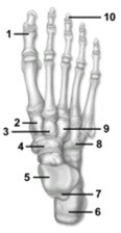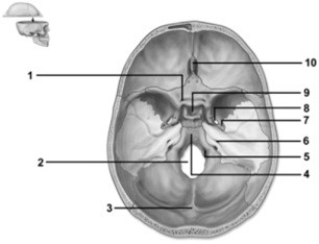Exam 8: Skeletal System: Axial and Appendicular Skeleton
Exam 1: The Sciences of Anatomy and Physiology131 Questions
Exam 2: Atoms, Ions, and Molecules140 Questions
Exam 3: Energy, Chemical Reactions, and Cellular Respiration127 Questions
Exam 4: Biology of the Cell158 Questions
Exam 5: Tissue Organization111 Questions
Exam 6: Integumentary System122 Questions
Exam 7: Skeletal System: Bone Structure and Function119 Questions
Exam 8: Skeletal System: Axial and Appendicular Skeleton203 Questions
Exam 9: Skeletal System: Articulations123 Questions
Exam 10: Muscle Tissue154 Questions
Exam 11: Muscular System: Axial and Appendicular Muscles183 Questions
Exam 12: Nervous System: Nervous Tissue161 Questions
Exam 13: Nervous System: Brain and Cranial Nerves161 Questions
Exam 14: Nervous System: Spinal Cord and Spinal Nerves143 Questions
Exam 15: Nervous System: Autonomic Nervous System140 Questions
Exam 16: Nervous System: Senses146 Questions
Exam 17: Endocrine System127 Questions
Exam 18: Cardiovascular System: Blood132 Questions
Exam 19: Cardiovascular System: Heart140 Questions
Exam 20: Cardiovascular System: Vessels and Circulation149 Questions
Exam 21: Lymphatic System84 Questions
Exam 22: Immune System and the Bodys Defense135 Questions
Exam 23: Respiratory System156 Questions
Exam 24: Urinary System161 Questions
Exam 25: Fluid and Electrolytes127 Questions
Exam 26: Digestive System141 Questions
Exam 27: Nutrition and Metabolism103 Questions
Exam 28: Reproductive System151 Questions
Exam 29: Development, Pregnancy, and Heredity127 Questions
Select questions type
The primary curves of the vertebral column are also called accommodation curves, while the secondary curves are also called ________ curves.
(Short Answer)
4.9/5  (35)
(35)
 -This figure shows the bones of the ankle and foot. Which number indicates the lateral cuneiform bone?
-This figure shows the bones of the ankle and foot. Which number indicates the lateral cuneiform bone?
(Multiple Choice)
4.9/5  (35)
(35)
Which of the spinal curves forms when a child is about 12 months of age?
(Multiple Choice)
4.9/5  (27)
(27)
Not counting sesamoid bones, what is the total number of tarsals, metatarsals, and phalanges in a single ankle and foot?
(Multiple Choice)
4.9/5  (28)
(28)
Of the following list, which describe the functions of the paranasal sinuses?
A: Warm and moisten inhaled air
B: Strengthen the bone
C: Provide resonance to the voice
(Multiple Choice)
4.9/5  (25)
(25)
The head of the ulna articulates with the distal medial surface of the radius known as the ulnar notch.
(True/False)
4.8/5  (39)
(39)
The ________ neck of the humerus marks the position of the former epiphyseal plate.
(Short Answer)
4.8/5  (39)
(39)
The crista galli of the ethmoid bone serves as a point of attachment for the falx cerebri of the dura mater.
(True/False)
5.0/5  (44)
(44)
The tubercle of rib 4 articulates with the transverse costal facet of T3.
(True/False)
4.7/5  (43)
(43)
 -This figure shows a superior view of the cranial cavity. Which number indicates the foramen ovale?
-This figure shows a superior view of the cranial cavity. Which number indicates the foramen ovale?
(Multiple Choice)
4.8/5  (34)
(34)
What is the name of the prominence on the medial surface of the ankle?
(Multiple Choice)
4.8/5  (38)
(38)
The cervical and lumbar curvatures are ________ curves, and they arch ________.
(Multiple Choice)
4.9/5  (38)
(38)
Showing 81 - 100 of 203
Filters
- Essay(0)
- Multiple Choice(0)
- Short Answer(0)
- True False(0)
- Matching(0)